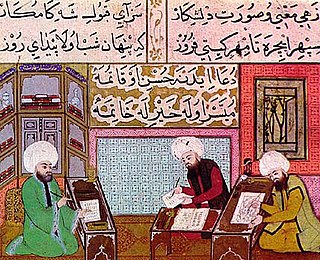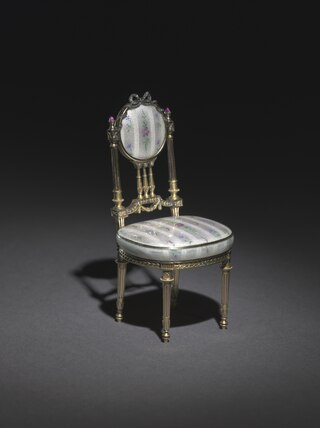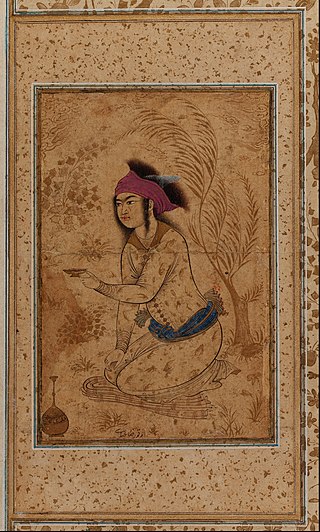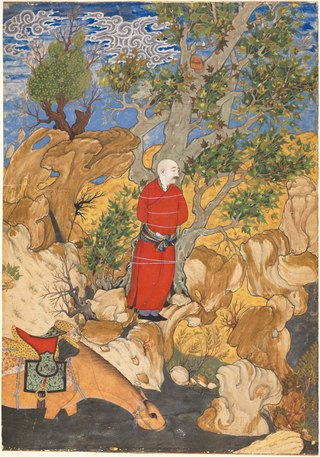Related Research Articles

Reza Abbasi, Riza yi-Abbasi or Reza-e Abbasi, رضا عباسی in Persian, usually Reza Abbasi also Aqa Reza or Āqā Riżā Kāshānī was the leading Persian miniaturist of the Isfahan School during the later Safavid period, spending most of his career working for Shah Abbas I. He is considered to be the last great master of the Persian miniature, best known for his single miniatures for muraqqa or albums, especially single figures of beautiful youths.
Thuluth is a script variety of Islamic calligraphy. The straight angular forms of Kufic were replaced in the new script by curved and oblique lines. In Thuluth, one-third of each letter slopes, from which the name comes. An alternative theory to the meaning is that the smallest width of the letter is one third of the widest part. It is an elegant, cursive script, used in medieval times on mosque decorations. Various calligraphic styles evolved from Thuluth through slight changes of form.

The arts of Iran are one of the richest art heritages in world history and encompasses many traditional disciplines including architecture, painting, literature, music, weaving, pottery, calligraphy, metalworking and stonemasonry. There is also a very vibrant Iranian modern and contemporary art scene, as well as cinema and photography. For a history of Persian visual art up to the early 20th century, see Persian art, and also Iranian architecture.

A Persian miniature is a small Persian painting on paper, whether a book illustration or a separate work of art intended to be kept in an album of such works called a muraqqa. The techniques are broadly comparable to the Western Medieval and Byzantine traditions of miniatures in illuminated manuscripts. Although there is an equally well-established Persian tradition of wall-painting, the survival rate and state of preservation of miniatures is better, and miniatures are much the best-known form of Persian painting in the West, and many of the most important examples are in Western, or Turkish, museums. Miniature painting became a significant genre in Persian art in the 13th century, receiving Chinese influence after the Mongol conquests, and the highest point in the tradition was reached in the 15th and 16th centuries. The tradition continued, under some Western influence, after this, and has many modern exponents. The Persian miniature was the dominant influence on other Islamic miniature traditions, principally the Ottoman miniature in Turkey, and the Mughal miniature in the Indian sub-continent.
Iranian-Armenians, also known as Persian-Armenians, are Iranians of Armenian ethnicity who may speak Armenian as their first language. Estimates of their number in Iran range from 70,000 to 200,000. Areas with a high concentration of them include Tabriz, Tehran, Salmas and Isfahan's Jolfa quarter.

Ottoman miniature or Turkish miniature was a Turkish art form in the Ottoman Empire, which can be linked to the Persian miniature tradition, as well as strong Chinese artistic influences. It was a part of the Ottoman book arts, together with illumination, calligraphy, marbling paper, and bookbinding. The words taswir or nakish were used to define the art of miniature painting in Ottoman Turkish. The studios the artists worked in were called Nakkashanes.

Miniature art includes paintings, engravings and sculptures that are very small; it has a long history that dates back to prehistory. The portrait miniature is the most common form in recent centuries, and from ancient times, engraved gems, often used as impression seals, and cylinder seals in various materials were very important. For example most surviving examples of figurative art from the Indus Valley civilization and in Minoan art are very small seals. Gothic boxwood miniatures are very small carvings in wood, used for rosary beads and the like.

Turkish art refers to all works of visual art originating from the geographical area of what is present day Turkey since the arrival of the Turks in the Middle Ages. Turkey also was the home of much significant art produced by earlier cultures, including the Hittites, Ancient Greeks, and Byzantines. Ottoman art is therefore the dominant element of Turkish art before the 20th century, although the Seljuks and other earlier Turks also contributed. The 16th and 17th centuries are generally recognized as the finest period for art in the Ottoman Empire, much of it associated with the huge Imperial court. In particular the long reign of Suleiman the Magnificent from 1520 to 1566 brought a combination, rare in any ruling dynasty, of political and military success with strong encouragement of the arts.

The Mimar Sinan Fine Arts University is a Turkish public university dedicated to higher education in the fine arts. It is located in the Fındıklı neighbourhood of Beyoğlu, Istanbul, Turkey.

Safavid art is the art of the Iranian Safavid dynasty from 1501 to 1722, encompassing Iran and parts of the Caucasus and Central Asia. It was a high point for Persian miniatures, architecture and also included ceramics, metal, glass, and gardens. The arts of the Safavid period show a far more unitary development than in any other period of Iranian art. The Safavid Empire was one of the most significant ruling dynasties of Iran. They ruled one of the greatest Persian empires since the Muslim conquest of Persia, and with this, the empire produced numerous artistic accomplishments.

A Muraqqa is an album in book form containing Islamic miniature paintings and specimens of Islamic calligraphy, normally from several different sources, and perhaps other matter. The album was popular among collectors in the Islamic world, and by the later 16th century became the predominant format for miniature painting in the Persian Safavid, Mughal and Ottoman empires, greatly affecting the direction taken by the painting traditions of the Persian miniature, Ottoman miniature and Mughal miniature. The album largely replaced the full-scale illustrated manuscript of classics of Persian poetry, which had been the typical vehicle for the finest miniature painters up to that time. The great cost and delay of commissioning a top-quality example of such a work essentially restricted them to the ruler and a handful of other great figures, who usually had to maintain a whole workshop of calligraphers, artists and other craftsmen, with a librarian to manage the whole process.

Mahmoud Farshchian is an Iranian painter and educator. He was a master of Persian miniature painting.

Ahad Hosseini is an Iranian Azerbaijani sculptor and painter.

Mansoor Ghandriz was an Iranian painter and printmaker. He used Iranian forms in modern art and was one of the pioneers of the Saqqakhaneh movement. Ghandriz is best known for his abstract paintings of mythical creatures.

Sadiqi Beg, also referred to as Sadiqi Beg Afshar, was a Persian painter, poet, biographer, draftsman, soldier and miniaturist of the Safavid period. He served as the head of the Royal Library serving under Shah Abbas I, and is most known for artistic reform.

Süleyman Seyyid Bey was a Turkish painter and art teacher, primarily known for his still-lifes. He taught art in military schools for 36 years and is considered to be a member of the first generation of modern Turkish painters in the Ottoman Empire.
Pariyoush Ganji (born in 1945) is an Iranian painter, designer, and educator. Her artwork and design has been influenced by traditional Persian art. Ganji lives in Tehran.

The Shahnameh of Shah Tahmasp or Houghton Shahnameh is one of the most famous illustrated manuscripts of the Shahnameh, the national epic of Greater Iran, and a high point in the art of the Persian miniature. It is probably the most fully illustrated manuscript of the text ever produced. When created, the manuscript contained 759 pages, 258 of which were miniatures. These miniatures were hand-painted by the artists of the royal workshop in Tabriz under rulers Shah Ismail I and Shah Tahmasp I. Upon its completion, the Shahnameh was gifted to Ottoman Sultan Selim II in 1568. The page size is about 48 x 32 cm, and the text written in Nastaʿlīq script of the highest quality. The manuscript was broken up in the 1970s and pages are now in a number of different collections around the world.
Contemporary Turkish Miniature refers to Turkish miniature art in Turkey from the mid-20th century to the present day. Contemporary Turkish miniature art is exactly the same art form as 16th-century Ottoman miniature; however, it is no longer just a book art and had developed into a fully standalone form of art with miniature artists depicting anything in any size they want while still using the same techniques as 16th-century miniature artists.
"The miniature painter of today observes, thinks and depicts in exactly the same way as his 16th century counterpart, but the manner of presentation, the lines and the colours vary in accordance with the individualstyle of the miniature painter himself, and we can see just as important differences between the various artists working today as between the great miniature painters of the past".
Hüseyin Tahirzade Behzat, or Hossein Taherzadeh Behzad Tabrizi, was an Iranian miniaturist painter, calligrapher, educator, and carpet designer. He is considered one of the most important miniature artists of Iran, and has produced approximately 400 articles and artworks. In the present day his miniatures and carpet designs receive a great amount of attention.
References
- ↑ "Son saray ressamı".
- ↑ "Home". haydarhatemi.com.
- ↑ "Hazar World - THE LAST OTTOMAN PAINTER AT THE ROYAL PALACE". www.hazarworld.com. Archived from the original on 2014-02-01.